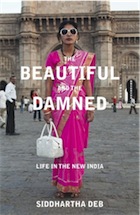Readers often
confuse fiction for non-fiction and vice versa, with narrators resembling
authors, fictional characters resembling real ones and real lives being
story-fied. So how does one categorize a book that explores a country of one billion
people by following five principal characters, a book whose first person
narrative is not explicitly the author’s voice?
 We settle into
our chairs to listen to Siddhartha Deb read from such a book, his latest work, The Beautiful and the Damned: A Portrait of
New India, to try to answer these questions.
We settle into
our chairs to listen to Siddhartha Deb read from such a book, his latest work, The Beautiful and the Damned: A Portrait of
New India, to try to answer these questions.
Deb does not
preface his reading with much context, although book includes a touching
Introduction about struggling with his slippery north-eastern Indian identity while
growing up, “resident of the land that my father had left and that I had never
lived in.” Today, he provides a bit of background about each passage he will
read from, letting the prose take over from there.
And he does,
with flair, turning the pages with the flourish of a piano player. Each excerpt
is dramatized as Deb reads slowly, pausing, smiling and inflecting to give us a
sense his exhausting and revealing travels throughout India:
Vijay
brought his tiny car to a halt, and the man loomed up in front of the
windscreen, a dark, stocky figure dressed in a T-shirt and jeans. He put his
right hand down on the bonnet of our car. In his left hand, he held an
automatic pistol, its barrel pointing up at an acute angle. His gaze, as it
swept over our faces, was intense, scrutinizing us carefully, meeting our eyes
for a few seconds.
Deb frequently
takes his eyes off the page to look straight at us and off to the side, and his
familiarity with the text makes his reading that much personal, the pistol that
much more tangible. Describing this police checkpoint on a highway out of
Hyderabad that Deb had driven on, he points out to us that not only was it
illegal, it was also in vain. His writing renders this impromptu call to action
utterly impotent in an impassive scene of oozing traffic and sense-numbing smog.
“The ‘I’ in the
book is not a journalist ‘I’. It’s more a narrator ‘I’ who has a history, has
memories,” he says. A combination that gives his characters histories and
memories, too, such as the wife of one of the few wealthy farmers in rural
Andhra Pradesh:
My
attention was drawn to the woman in her thirties, everything about whom
suggested that she was the mistress of the house. She was wearing a bright blue
sari, from the fringes of which one foot displayed a gleaming golden toe ring.
She was slightly plump, and light-skinned – attributes that declared the upward
mobility of the man who had married her with as much clarity as the marble and
teak fittings of the house.
Deb remarks a
paragraph later that this woman does not seem fazed by the charred, dusty state
of her house—recently set on fire by angry famers cheated out of their revenue
by her husband—nor by her husband’s feckless behavior. The way she carries
herself reflects her standing: a woman of higher social class than the farmers
in the town, a woman with property, a woman with status and promise.
Less classily
portrayed is the infamous and now defamed personality, Arindam Chaudhuri.
People told Deb that he seemed “grotesquely fascinated” with Chaudhuri, that he
explored—and exploited?—Chaudhuri’s life more critically than he did other
characters in the book. Why? Deb argues that he took much care to respect the
privacy of his characters, omitting details and changing names when asked.
Chaudhuri, however, was already a grandiose figure in India, notoriously
ubiquitous, dominating print advertisements and amplifying his voice to the
masses. Such a persona could not expect already public information about him to
be disguised for the sake of a book.
Deb boldly depicts
Chaudhuri as the meretricious scammer that he is, sneaking snippets into his
writing that wonder about his unexpected popularity and influence:
The
mannerisms gave Arindam an everyday appeal, and it was the juxtaposition of
this homeliness with his wealth, success and glamour that created a hold over
the leadership aspirants in the audience…He was one of the audience, even if he
represented the final stage in the evolution of the petite bourgeoisie…after
about thirty minutes into the leadership session, as I began to be drawn into
his patter, I felt that Arindam was telling the rising Indian middle class a story
about itself, offering them an answer to the question of who they were.
Chaudhuri, a
business man, business school founder, public speaker, entrepreneur, Bentley
owner and global consultant—among other things—was outraged when Deb’s book was
completed. He has since sued for defamation, insisting that the chapter about
him is inaccurate and tainting. Quite creatively, Deb tells us, he has filed an
injunction in Silchur, a dot of a city in Assam in north-eastern India,
hundreds of miles away from the courts, publishing houses and newspapers of
Delhi. Not only has Chaudhuri taken great pains to travel this far to file a
lawsuit for Rs. 500 million, but he is filing it against four parties:
Siddhartha Deb, Penguin Publishers, Caravan Magazine (that printed an excerpt
from Deb’s book featuring—or exposing—Chaudhuri) and Google India!
Deb deadpans
that Google India’s probably auto fills the word ‘fraud’ when someone types
‘Arindam Chaudhuri’ into the search bar, and this must make Chaudhuri very
angry.
Anger is
prevalent throughout the book, not surprisingly, as Deb talks to the
marginalized, the invisible, the unpaid, the evicted, the toiling, the cheated,
the rip-offs and the jaded. In the final section featuring a north-eastern girl
working as a waitress in Delhi, the anger matures into gritty determination and
hard-earned independence. Esther (not her real name) is optimistic about making
a life for herself in a metropolis, but she tires of the superficial,
ultimately inaccessible, glitz of her job in food and beverages (F&B) The
redundancy of routine and responsibility wear her down.
‘I
feel like a thief,’ she said. ‘When I come home, everyone’s sleeping. It’s a
strange job that requires you to be up when everyone else is in bed.’
Esther’s section
is sympathetic and admiring, prompting the reader to wonder, did Deb get more
involved with her than with his other characters? The moderator says that many
reviewers have suggested a romantic relationship, which Deb corrects: “One!”
Gesturing
animatedly, Deb insists that there was no romance: his sole aim was to
“dissolve the boundaries between the observed.”
These
days Esther spoke differently about her job. ‘I wanted to be a doctor, not this
F&B. Sometimes, I want to go back home, but what is there back home? If I
go home, what will I do? But this job has no security, no pension.’…what Esther
sometimes wanted, after all her independence, striving, exposure and mobility
was a simple repetition of her mother’s life.
Questions follow
his reading. Deb advocates for his narrator, who is “pretty angry and pretty
skeptical about what he’s seeing.” This first-person narrator is a microphone
for his characters, for the four years of research he has done all over the
subcontinent. “I am not pretending to be objective,” he says.
 Deb defends his
preference for fiction over non-fiction. “I actually prefer the novel as a form,”
he explains, but thought initially that non-fiction would be more effective for
such a subject. He thought it would be quicker, too, and that he would “make a
ton of money, come back to fiction.” So much for that, he laughs. “Here I am, six years later!”
Deb defends his
preference for fiction over non-fiction. “I actually prefer the novel as a form,”
he explains, but thought initially that non-fiction would be more effective for
such a subject. He thought it would be quicker, too, and that he would “make a
ton of money, come back to fiction.” So much for that, he laughs. “Here I am, six years later!”
When asked about
the seamless transitions between characters, villages and personal
contemplations, Deb describes the tiring, painstaking attention to detail a
writer must have, especially since it yields richer, truer stories. “A lot of
the shaping happens in the writing as well,” he says—the mark of a practiced
and accomplished writer.
Writing a book
of such ambitious scope takes commitment, curiosity and, ultimately, a profound
need to capture the world in your own words. “If you hit it,” he promises, “it’s
the most transcendent thing. It comes alive.”
 As part of PEN's World Voices Festival this year, Pulitzer Prize winner Jennifer Egan spoke at The New School about the 'rules' of craft. She was asked mostly about A Visit from the Goon Squad and her answers incorporated larger views about the politics and practices of writing. A few memorable moments--
As part of PEN's World Voices Festival this year, Pulitzer Prize winner Jennifer Egan spoke at The New School about the 'rules' of craft. She was asked mostly about A Visit from the Goon Squad and her answers incorporated larger views about the politics and practices of writing. A few memorable moments--









